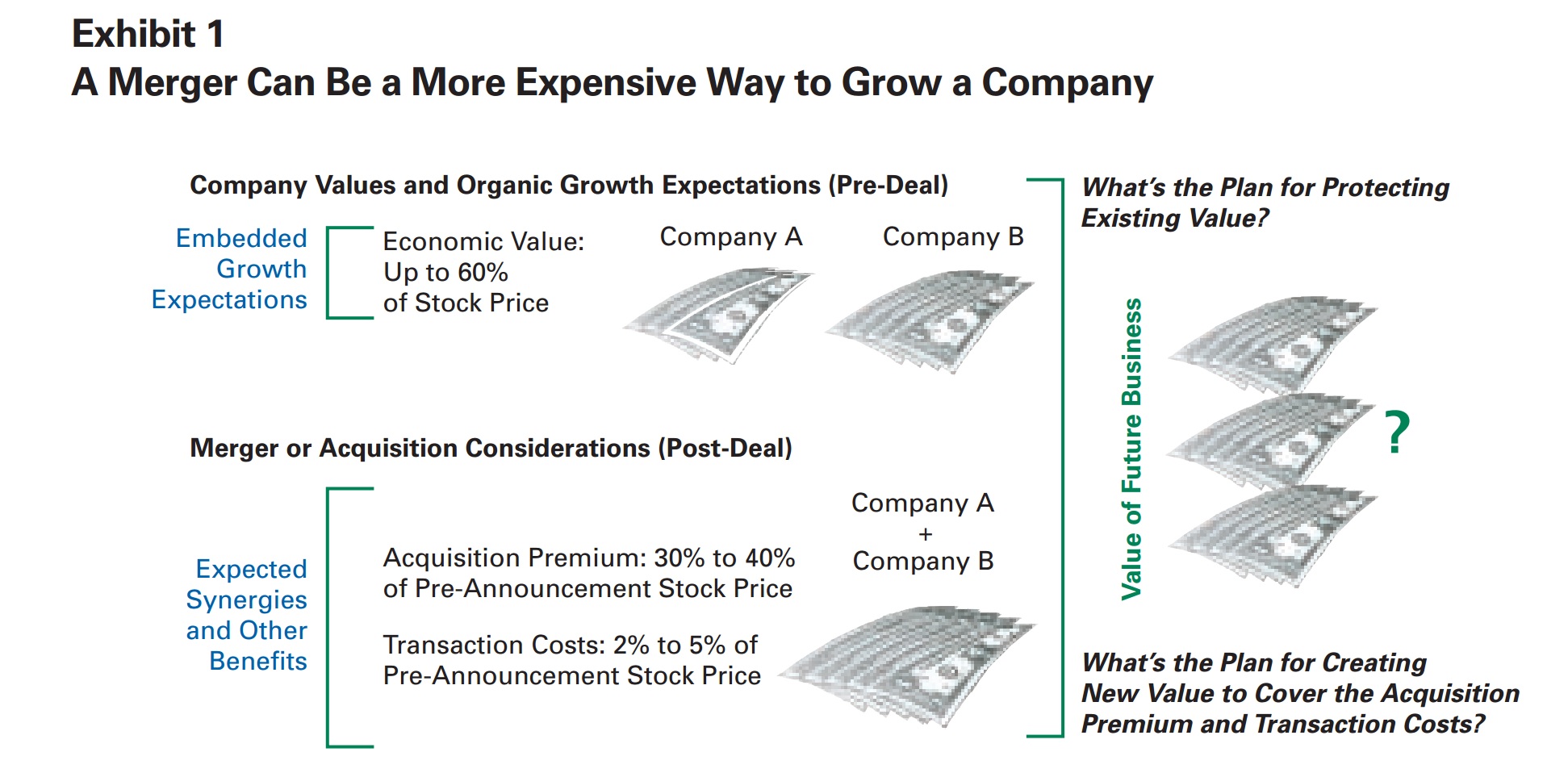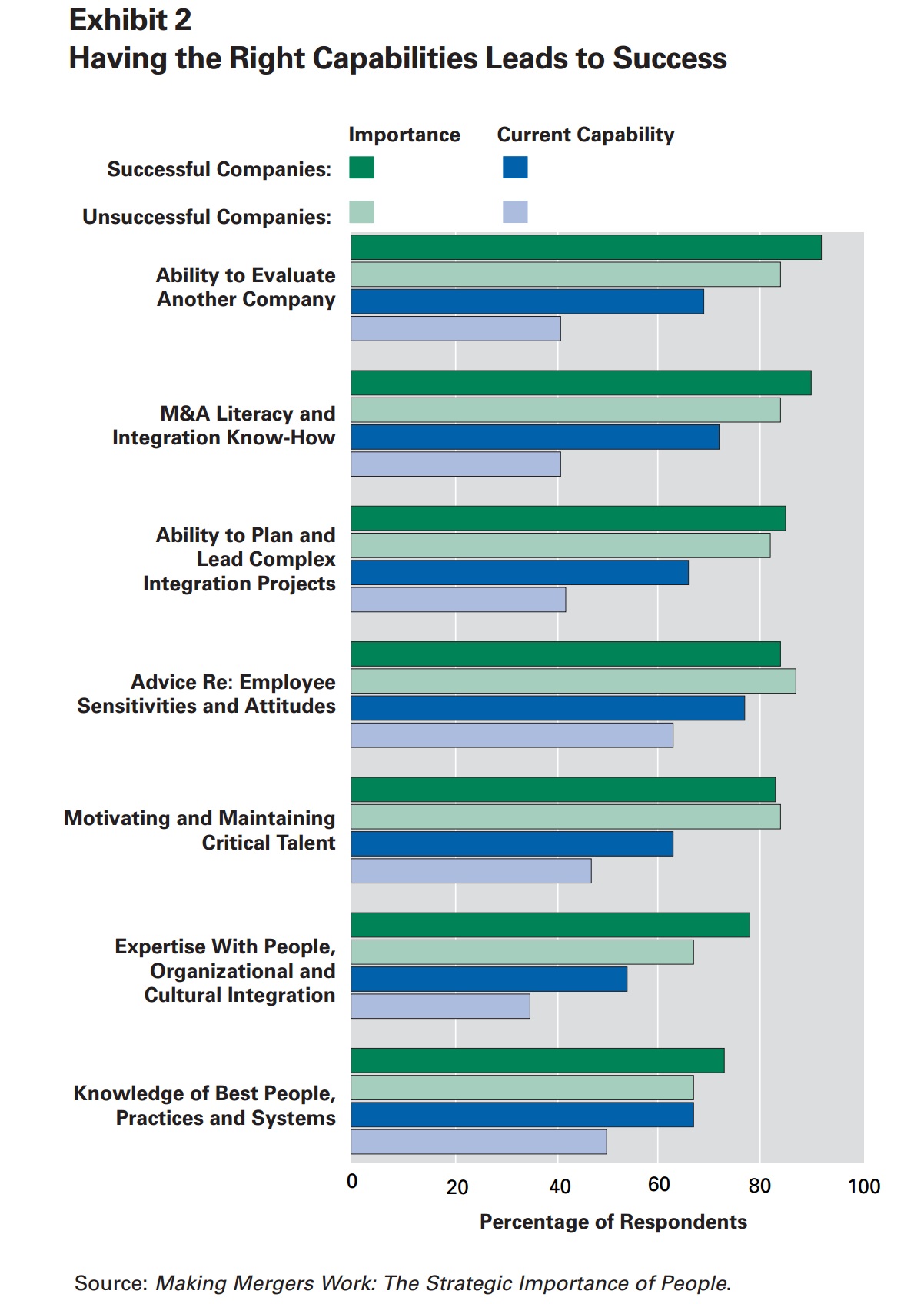
Publications Why HR Can Make or Break Your M&A
- Publications
Why HR Can Make or Break Your M&A
- Bea

SHARE:
By Andrew F. Giffin and Jeffrey A. Schmidt
In implementing an M&A, most managers focus on the financials. But success often hinges on how you deal with people issues and cultural integration. Is your HR unit up to the task?
In 2001, an admittedly sluggish year for mergers and acquisitions, the global financial services industry undertook M&As valued at more than $100 billion, placing it among the top 10 industries in M&A activity. Some of the major buyers included American International Group, Prudential, Swiss Reinsurance and Wellpoint Health Networks.
Unfortunately, many mergers and acquisitions fail to meet their objectives, which are typically to accelerate growth, cut costs, increase market share or take advantage of other synergies. The recent announcement by AOL Time Warner that it will charge up to $60 billion to its net worth for impaired goodwill from past deals underscores the burdensome legacy that many companies confront long after completing their mergers or acquisitions.
Why do so many M&As fail to meet expectations? And what can organizations do to improve the chances of a successful deal?
Deals Can Fail for People-Related Reasons.
The financial services industry has had its share of underperforming deals. These deals failed not only for strategic fit or financial reasons, but also for people-related ones. For example:
- Management couldn’t agree on the future direction of the company.
- Uncertainty paralyzed the organization.
- Key employees departed or customers defected.
- Cultures clashed.
- Employees did not understand what was expected of them in the new company and morale plummeted.
For insurers, the problems are compounded when two companies:
- combine mature, low-growth businesses
- fail to cut duplicate cost structures as expected
- are unable to rationalize or coordinate distribution networks
- face expensive systems reconciliation
- experience conflicts in combined management. Nonetheless, the life insurance industry, in particular, plans to continue merger activity as its primary growth strategy because most believe it has been effective in the past.
M&As: High Risk, High Reward?
Mergers and acquisitions are a high-risk way to grow a business. And with the Financial Accounting Standards Board’s new regulations governing write-offs of goodwill assets gone bad, the risks have become even greater. This is not work for the inexperienced or the fainthearted.
Exhibit 1 compares the benefits of an M&A deal to those resulting from organic growth.
A company’s stock price reflects investor confidence in the company’s ability to deliver value from its asset base and future growth. But a merger or an acquisition changes the rules of the game. For the deal to succeed, the newly formed company must beat the pre-announcement market expectations for the target company by a substantial margin.
In other words, to succeed, the new company must quickly recapture the premium paid for the target plus transaction costs plus expected organic growth rates. Those financial hurdles can be high. In 2001, for example, financial services companies paid prices that ranged from about 115% to more than 185% of book value to acquire targets, including some significant premiums on estimated value in many cases.
The acquisition premium is recognized as goodwill on an acquiring company’s balance sheet and reflects the purchase price for the target company’s intangible assets, which include human and structural capital, customer equity and intellectual property. FASB now requires the new company to write down the overvalued goodwill that is taken as a charge against net worth as soon as the basis for the writedown is known. Some of these write-downs will be quite large.
Today, several companies in financial services carry merger-related goodwill on their books equal to their market capitalization or book value. And taking substantial write-downs on bad goodwill assets in such cases has consequences. Although it doesn’t require any cash outlays, taking a write-down will have a negative effect on a company’s net worth. It will trigger careful scrutiny by rating agencies, regulators and investment analysts and will likely have a harmful impact on stock price.
Why does goodwill become impaired? For one thing, in the excitement of the M&A process, many companies greatly overestimate the potential synergies, especially those intended to drive top-line revenue growth. They also tend to overestimate the potential for cost reduction. Sometimes — especially in a bidding situation — successfully outbidding another buyer may result in paying too high a premium for the target.

Leveraging Synergies: The Road to Merger Success
Acquirers seek to satisfy merger goals in financial services by offering a wider range of products and services to customers, broadening geographic reach and achieving greater economies of scale. Accomplishing these implementation objectives, however, depends on smooth and effective integration. This entails channeling the skills and enthusiasm of employees, merging the intellectual capital of both organizations and streamlining the way in which the new business operates so that it can rapidly overcome hurdles and take advantage of synergies and reduce unit costs.
In short, success depends on aligning the people, organizational and cultural assets of the new entity. Once a deal is sealed, nothing is more important to a successful outcome than effectively managing these “soft” issues.
In the heat of a merger or an acquisition, financial services executives naturally focus on financial due diligence, risk assessments, analyst and investor relations, and the ways in which the new entity will create shareholder value. But the hurdles to success can relate directly to such people issues as workforce management and cultural integration. Finessing these soft issues is the hard part of integration and has the strongest influence on a deal’s long-term success.
A survey of more than 450 senior HR executives from large companies involved in mergers, acquisitions or joint ventures sought to identify the major obstacles to M&A success. The top seven obstacles all related, directly or indirectly, to people issues. Even the No. 1 hurdle — the inability of the combined organization to sustain financial performance — translates into a loss of productivity and, perhaps, uncertainty and confusion in the workplace.
How respondents dealt with these obstacles reveals a major difference between companies that achieved their M&A goals and those that did not. (See Exhibit 2.) Clearly, companies that focus on these issues stand a better chance of success.

The Four Stages of a Merger or an Acquisition
Most mergers and acquisitions follow a four-stage process:
- Pre-Deal. Based on its growth strategy, the acquirer searches for an appropriate target or partner, assesses potential targets and develops a plan for executing the deal.
- Due Diligence. After making the offer, the acquirer ensures that the deal is strategically and economically sound and has a high likelihood of success. Thorough, detailed execution of this stage is particularly critical for financial services companies.
- Integration Planning. The acquirer creates a comprehensive plan for integrating the two organizations. This stage takes place within the first 100 days of the decision to merge and can begin during due diligence if both sides believe the deal will go forward (pending regulatory approvals).
- Implementation. The final stage builds on all the planning that has gone before. Implementation can take months or even years to complete, depending on the complexity of the deal and the size of the merging companies.
Managing the People Aspects of a Merger
If one assumes that human resources is the unit best equipped to help the new company manage the people-related issues of a merger, the next step is to look at how HR functions during a merger or an acquisition. According to the survey of human resource professionals, HR generally did not get involved in the merger process until after the pre-deal and due diligence phases, although successful companies tended to have HR involved much earlier than did unsuccessful companies.
What role should HR play in the merger stages?
- Pre-Deal. In addition to defining the financial and business aspects of a good merger candidate, HR can help define the cultural aspects. 8 2002/2 Percentage of Respondents Ability to Evaluate Another Company M&A Literacy and Integration Know-How Ability to Plan and Lead Complex Integration Projects Advice Re: Employee Sensitivities and Attitudes Motivating and Maintaining Critical Talent Expertise With People, Organizational and Cultural Integration Knowledge of Best People, Practices and Systems 0 20 40 60 80 100 Successful Companies: Unsuccessful Companies: Importance Current Capability Exhibit 2 Having the Right Capabilities Leads to Success Source: Making Mergers Work: The Strategic Importance of People. Is the acquirer looking for a company that has a compatible culture? Or one that is more entrepreneurial? Do lines of business that are to be combined have compatible success requirements (e.g., aggressive marketing versus careful risk selections)? Will a particular combination include required overall investment and risk management capabilities? What type of company will have the best distribution systems?
- Due Diligence. Once a partner has been identified, HR can help assess its culture. Do the companies differ drastically in management style? Are there potential HR financial issues (e.g., an underfunded pension plan or postretirement benefits)? How confident is management of capturing the specific synergies of the deal?
- Integration Planning. HR is likely to be the most qualified party to understand and execute such integration-planning activities as developing employee communication strategies, programs to retain key talent and organizational and staffing plans. Another crucial HR role — helping employees cope with change — has far-reaching consequences, including maintaining productivity, stemming the loss of key talent and smoothing the integration of the two cultures. Change can be particularly difficult for employees involved in a merger or an acquisition, especially those who work for the target. Unanswered questions about job security, relocation and new reporting relationships — even changes in benefit programs — spawn rumors, anxiety, resentment and the loss of top talent, who can most easily find jobs elsewhere. All this can lead to lower productivity and diminution of a company’s intangible assets. In the growing world of global financial services mergers, these issues take on heightened importance.
HR: Ready or Not?
The crucial question for financial services companies is whether HR is up to the task of playing a strategic role in a merger or an acquisition. If HR has traditionally served as a technical expert (e.g., focusing on benefit administration and hiring programs), its leaders are not likely to be inclined or prepared to play a strategic role.
One of the most important ways that a CEO or an M&A team can improve the probability of success is by getting HR involved early — as soon as the organization begins thinking about its acquisition criteria and possible targets and well before integration planning begins. Second, the chief executive should clarify HR’s role in the M&A and give the head of HR a seat at the management table. The senior HR executive should provide advice on such essentials as retaining key talent, communicating to employees, taking steps to combine cultures and developing processes for managing different benefit programs.
If HR leadership is not strategic enough to participate early in M&A planning, the organization should consider how to transform HR into a strategic player. This may entail divesting HR of its more routine chores — benefits enrollment and basic administrative tasks that can be outsourced or turned into a self-service function via the Web. This would allow HR to focus on providing high-level counsel to senior management on such topics as strategic staffing, long-term incentive plans and methods for developing a world-class workforce.
To meet these obligations, senior HR practitioners must understand how the business functions, its goals, financial operations, marketing and product/service development, as well as how the business fits into the competitive landscape. Only when HR is as business savvy as the rest of senior leadership and approaches its functions from a strategic perspective will it earn a seat at the management table.
M&As provide enormous potential for growth that simply can’t be achieved as quickly through organic, incremental development. However, success rates are not very high, rendering them an expensive and very risky way to grow a business. When financial services companies pay close attention to the people aspects of a merger or an acquisition, they greatly increase the chances that the deal will fulfill its promise. That’s why, in the final analysis, HR can make or break an M&A.
TAGS:


Stay up to date with M&A news!
Subscribe to our newsletter


